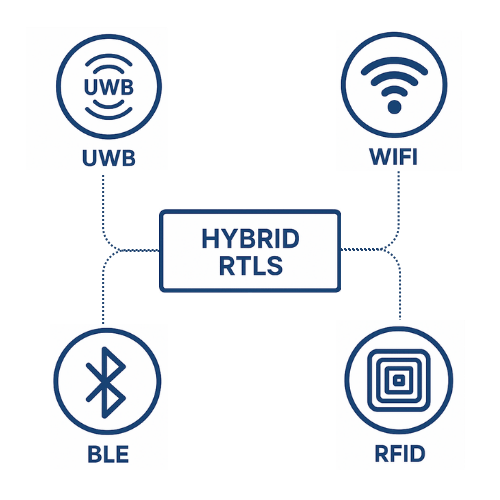What is a Hybrid RTLS?
A Hybrid RTLS (Real-Time Location Systems) is an advanced solution that combines multiple location tracking technologies—such as RFID, Bluetooth Low Energy (BLE), Ultra-Wideband (UWB), Wi-Fi, and sometimes GPS—within a unified infrastructure. Unlike traditional RTLS deployments that rely on just one technology, hybrid RTLS models offer increased coverage, flexibility, and precision by leveraging the distinct strengths of each technology. Hybrid RTLS has rapidly become indispensable for industries requiring reliable and seamless indoor and outdoor asset and personnel tracking.

The Benefits of Hybrid RTLS for Indoor and Outdoor Applications
Unmatched Versatility: Hybrid RTLS provides adaptability in a wide range of environments. UWB may be used for high-precision indoor tracking, while Wi-Fi or BLE offers cost-effective, building-wide coverage. RFID or GPS can bridge the gap when transitioning between indoor and outdoor spaces—ensuring no loss of visibility.
Scalable Infrastructure: Businesses can tailor their RTLS deployments according to operational complexity. Multi-protocol gateways and scalable middleware architectures accommodate new tracking requirements or technologies without a complete infrastructure overhaul.
Enhanced Accuracy & Coverage: Combining technologies reduces blind spots and improves location accuracy. For instance, critical equipment can be tracked within centimeters indoors using UWB, but switches seamlessly to BLE/Wi-Fi as assets move through different facility zones.
Cost Optimization: Rather than relying on a single, high-cost technology for every application, organizations can mix and match cost-effective technologies, aligning capital expenditure with the specific needs of each tracking area.
Business Intelligence Integration: Hybrid RTLS systems provide rich, real-time data for operational analytics, process automation, and integration with enterprise platforms (ERP, WMS, MES). This leads to better decision-making and improved safety compliance.
Typical Hybrid RTLS Architecture: How Does it Work?
Hybrid RTLS deployments typically involve three core architectural layers:
1. Hardware Layer:
Multi-technology tags and sensors (BLE beacons, UWB anchors, RFID tags, Wi-Fi modules)
Gateways that support multiple protocols to receive and transmit signals
2. Middleware Layer:
Data aggregation and protocol translation
Real-time location calculation engines
APIs and message buses to integrate RTLS data with enterprise applications
3. Application Layer:
User dashboards, maps, and reporting tools
APIs interfacing with business and operational systems
Security, privacy, and compliance modules
This layered approach enables real-time, seamless tracking and ensures future scalability.
Real-World Applications and Use Cases
Healthcare:
Track medical equipment, patients, and staff across complex hospital environments, including between floors and even buildings, ensuring safety and asset optimization.
Manufacturing & Logistics:
Monitor assets and personnel as they move between warehouses, production zones, and outdoor logistics yards. Hybrid RTLS is essential for cold chain monitoring and container tracking across diverse temperature zones.
Smart Buildings:
Integrate with access control, safety systems, and building management to enable location-aware automation and emergency response.
Other Sectors:
Retail (inventory management), airports (baggage tracking), and construction sites (worker safety and progress monitoring) are also adopting hybrid RTLS.
Challenges in Implementing Hybrid RTLS Models
System Complexity:
Integrating multiple protocols, hardware types, and vendor solutions requires careful system architecture and strong middleware. Interference and protocol conflicts must be managed.
Standardization:
The lack of universal standards can impede interoperability between devices and software, increasing deployment risks and costs.
Scalability and Maintenance:
As system complexity grows, so does the need for robust monitoring, fault tolerance, and continuous optimization to avoid performance bottlenecks.
Cost and ROI Assessment:
Initial setup costs can be high, especially in retrofitting existing infrastructure. Businesses should carefully plan phased rollouts and pilot projects to validate ROI.
Data Security and Privacy:
Expanded tracing capabilities require advanced security measures and adherence to data privacy regulations (especially in healthcare and workforce monitoring).
Future Trends in Hybrid RTLS
AI and IoT Integration:
The convergence of AI with RTLS enables predictive analytics and intelligent automation (e.g., predicting equipment failure before it occurs).
Edge Computing:
Processing location data closer to the source (at the network edge) reduces latency and improves reliability for time-critical applications.
Standardization and Open APIs:
Growing adoption of open standards and modular APIs is streamlining integration and future-proofing investments.
Key Takeaways
Hybrid RTLS technologies are reshaping the landscape of real-time location tracking. By uniting multiple location-tracking protocols, businesses can achieve the accuracy, coverage, and scalability needed for modern, connected operations. While implementation brings technical challenges that must not be underestimated, the advantages—operational intelligence, resource optimization, and a seamless end-user experience—are driving hybrid RTLS adoption across industries.